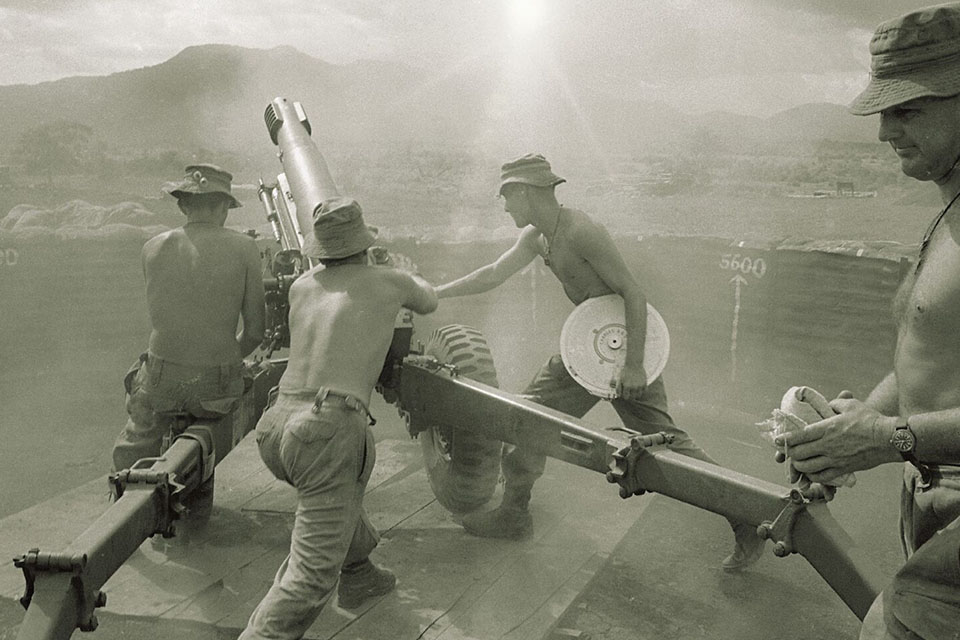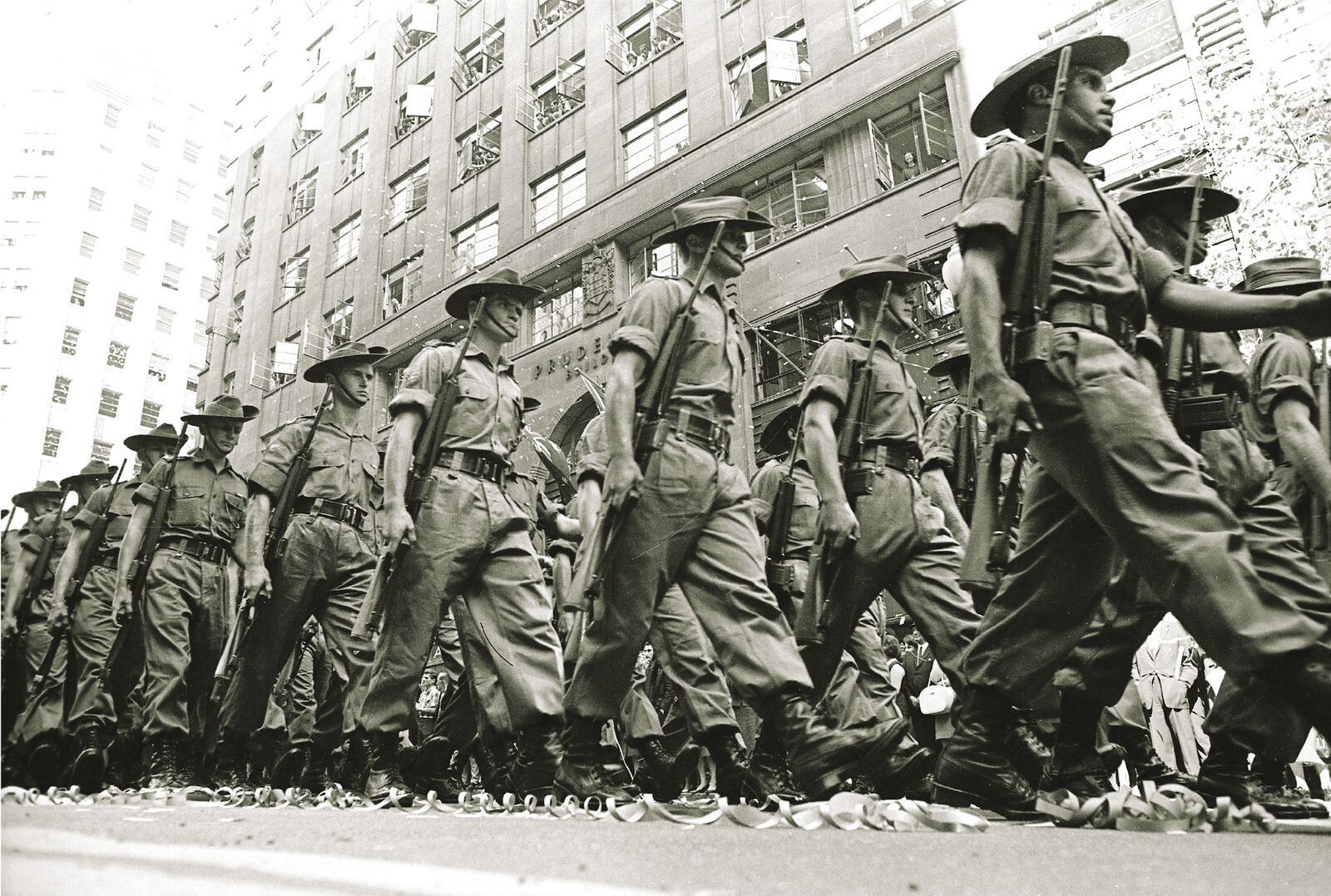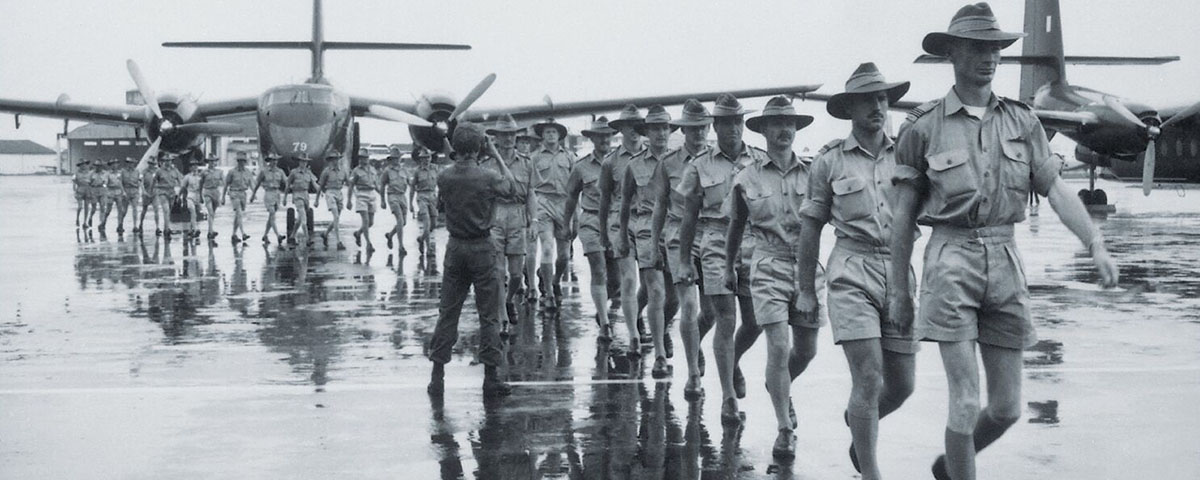Joining the American intervention in Vietnam, Australia experienced similar battlefield successes in-country and political setbacks on the homefront
Among the more memorable images from the United States’ long, controversial involvement in Vietnam is a photo depicting dozens of desperate people scrambling up a ladder to board a UH-1 helicopter perched on a narrow rooftop in the embattled city of Saigon. The date was April 29, 1975, and the CIA-operated Air America Huey was evacuating some of the last South Vietnamese officials and U.S. Embassy personnel to escape the city before its fall to North Vietnamese and Viet Cong forces.
Not as well known to Americans, but of equal import to Australians, was a similar evacuation four days earlier and only a few miles away. On April 25 two C-130 Hercules transports of the Royal Australian Air Force had taken off from Saigon’s Tan Son Nhat Air Base carrying the last of its country’s diplomats and military attachés to leave the doomed capital of the Republic of Vietnam. Though Australian troops had ceased operations back in January 1973, the closure of Canberra’s embassy and departure of its personnel marked the true end of Australia’s longest and most controversial military conflict of the 20th century.
The origins of Australia’s participation in the Vietnam War is traceable to France’s colonial rule in the region before and during World War II. While Western interest in Indochina had originated in the 16th century—at a time when Europe sought to expand its overseas markets—France did not formalize its takeover of Vietnam until the late 1880s. It benefitted from both the export of raw materials (principally rubber) and the opening of Asian markets to products from mother France. As the French established plantations, factories and mines throughout Vietnam, the administrators took advantage of the native workforce, compelling the traditionally agrarian Vietnamese to leave their villages and move to the growing network of French-built cities and towns. Infrastructure improvements didn’t temper the sting of cultural alienation and looming anti-French sentiment.
With the onset of World War II, French colonial domination of the region began to crumble. Germany’s 1940 invasion of France and the latter’s subsequent capitulation opened all of Indochina to Japanese occupation. While Vichy French officials ostensibly continued to wield civil authority, Tokyo dominated the former colony, using it as a base from which to launch air and naval sorties against the Allies. Meanwhile, Soviet-steered Marxist parties coalesced to exploit the general discontent. Vietnamese resistance against both the Japanese and French ramped up with the 1941 establishment of the communist-dominated Viet Minh, under the leadership of Ho Chi Minh. With military support from the United States, the Viet Minh fought an effective insurgency, tying down Japanese units that would otherwise have been in action against the Allies. Following Japan’s surrender the Viet Minh resisted France’s efforts to renew its colonial hold on the region, and the conflict escalated. France was unable to impose a military solution, China provided support to the communists, and under the terms of the 1954 Geneva Conference the country was partitioned into the communist North and democratic South.
In the early 1960s, political stability in South Vietnam took a downward spiral, as the North fueled the flames of dissent. Hanoi’s increasingly obvious attempts to undermine the republic—primarily through its support of Viet Cong guerrillas—led the United States to act to counter the spread of communism. By late 1963, some 16,000 U.S. military advisers were at work in South Vietnam, but even this contribution did little to stem the threat. By early 1965, the Viet Cong had destroyed some 7,500 South Vietnamese hamlets. The choice for the United States was clear: Intervene more broadly and forcibly in resisting the communists, or allow them to take over South Vietnam.
That spring President Lyndon B. Johnson ordered regular U.S. combat units into South Vietnam and sought military support from several nations, including Australia. Canberra sent its first 30 military advisers to Vietnam in 1962. Over the next two years, it added aviators, engineers and medical personnel to the mix. In April 1965, Prime Minister Robert Menzies agreed to expand Australia’s contribution to include regular combat forces.
Menzies’ rationale for entering the war is manifest. Australia’s location makes it particularly vulnerable to security threats emanating from Southeast Asia, and in the decade following World War II the most potent threat was the spread of communism. Johnson and Menzies were proponents of the “domino theory,” which suggested that the fall of even one state to communism in a given region would encourage similar insurgencies in neighboring states. President Dwight D. Eisenhower had first expressed the theory during a 1954 news conference, and growing concern had prompted Australia to contribute ground, air and naval forces to the successful British-led war against communists in Malaya, which ended in 1960 with the insurgents’ surrender. Menzies was also keen to maintain a special security arrangement with the United States and regarded the commitment of armed forces in Vietnam as a sort of “insurance policy” to bolster Australian-American relations.

In June 1965 the light aircraft carrier HMAS Sydney, carrying men of the 1st Battalion, Royal Australian Regiment, a troop of the Prince of Wales’ Light Horse armored regiment and a logistics unit, made port at Vung Tau, just east of Saigon. These initial Australian forces were attached to the U.S. Army’s 173rd Airborne Brigade in nearby Bien Hoa Province, and over the following months 1RAR participated in several significant actions. While relations between the Americans and Australians were generally good, early joint operations revealed significant differences in both policy and tactics. Senior Australian officers were concerned that prolonged attachment to aggressive U.S. combat forces might result in higher casualties among their own men. Indeed, at one point Chief of the General Staff Lt. Gen. Sir John Wilton sardonically commented that the Australians could not allow themselves the kind of generosity in the loss of life the Americans seemed able to sustain.
Regardless, in April 1966 Canberra made a significant policy shift and expanded Australia’s military commitment in Vietnam, deploying two additional battalions of the RAR, support units and a squadron of the elite Special Air Service Regiment. Designated the 1st Australian Task Force, the expanded formation was assigned responsibility for Phuoc Tuy Province and operated independently, not as a reserve force for the Americans. Based on a rubber plantation near centrally located Nui Dat, the Australians were to seek out and engage enemy main-force units. Their air base was within striking distance of the main population centers to ensure good communication with villagers and the ability to quickly disrupt Viet Cong infiltration. Such “pacification” efforts represented a more humane approach to military action and fostered cooperation among the populace.
Thus the Australians were able to conduct regular patrols and quash enemy forces in the challenging jungle. Yet by 1968 Canberra had concluded an expansion of Australian forces in Vietnam was warranted. The resulting introduction of another infantry battalion, additional helicopters and a squadron of Centurion tanks allowed the task force to undertake a wider range of operations.
Offsetting the benefits of such buildup operations was the enemy use of landmines and booby traps, insidious devices that inflicted nearly half of all Australian casualties. The Viet Cong were confident they had found an ideal means of warfare, as the devices married low-cost technology with low risk, a combination that out of necessity aligned with the guerrillas’ philosophy of war. There was also a psychological component to such devices, as Australians patrolling through scrub and tall grass in the unbearable heat always had it in the back of the mind that a booby trap or mine may lay in waiting. For the Aussies’ part, their ability to patrol seemingly at will had fostered a measure of complacency, lulling them into the mistaken belief that where the enemy was ostensibly absent, there was little to fear. Further hampering operations were communist informants in the surrounding villages.
Despite such setbacks, however, the Australians demonstrated a remarkable ability to adapt and confront the Viet Cong on their home ground. Aiding their efforts were veterans of the Malaya campaign, who had learned to deal with the difficult conditions of jungle fighting and counterguerrilla operations and were able to share invaluable advice on tactics associated with such engagements. They underscored the importance of conducting cautious, methodical patrols.
By July 1966, the Australian presence was a firmly embedded thorn in the side of the communists. Convinced only a full-scale operation would dislodge the Aussies from Phuoc Tuy, the Viet Cong sent their 275th Regiment against the air base at Nui Dat. In the subsequent Battle of Long Tan, a lone Australian company outnumbered by some 20-to-1—exhibited remarkable courage and perseverance despite a lack of food, water and ammunition and the presence of leeches, flies, mosquitoes and snakes.
The clash began at 2:43 a.m. on August 17, when the Viet Cong hit Nui Dat with a sustained bombardment by artillery, mortars and recoilless rifles, until silenced by counterbattery fire. The next morning Company B, 6RAR, sallied out to determine the location and size of the enemy force but found only abandoned firing positions. At noon the regiment’s Company D took up the chase. While pursuing a Viet Cong squad, the company came under flanking attack by rocket-propelled grenades about the time a monsoon storm cut visibility to near zero. Lacking any obvious route of escape, the 100-plus men found themselves pinned down by an enemy numbering around 2,000. They fought on in the rain-swept darkness and were nearly out of ammo when relieved by artillery and air support, followed by ground reinforcements. The Australians lost 18 killed and 24 wounded—more than a third of the engaged force.
The Viet Cong sustained at least 250 killed and an even greater number wounded—far steeper casualties than those of their adversary and a hallmark of the war in general. Back home, in a spurt of patriotism evocative of World War I, the Australian media focused on the tactical coup their armed forces had achieved. Even allowing for the inevitable wartime exaggeration of enemy casualties, the battle was a decisive Australian victory.
The next major encounter came during Operation Bribie, a strike by an Australian quick-reaction force against infiltrating Viet Cong. On Feb. 17, 1967, the VC attacked a South Vietnamese compound at Lang Phuoc Hai, soon withdrawing under artillery fire and air strikes. As had happened at Long Tan, the Australians sought to engage the retreating elements and found themselves embroiled against the bulk of the communist force. Though the opposing units were more evenly matched, by day’s end the Aussies had lost eight killed and 27 wounded.
The Australians’ largest unit-level engagement of the war was the Battle of Coral–Balmoral. In May and June 1968 the Aussies joined U.S. and New Zealand troops seeking to cut off retreating enemy forces after a failed communist offensive against Saigon. In a period of nearly sustained combat over 25 days the Australian units repeatedly beat back determined attacks from overwhelming North Vietnamese forces before being relieved by U.S. and South Vietnamese reinforcements. It proved the Australians’ costliest clash of the war, resulting in 25 killed and 99 wounded. They inflicted 10 times that number of casualties on the communists.
A year later the Australians scored a decisive victory at the village of Binh Ba—a win that managed to temporarily drive communist forces from Phuoc Tuy Province. Though the village was ostensibly under South Vietnamese protection, the North Vietnamese and Viet Cong contested that control on the evening of June 5, 1969, by sending an occupying force comprising two infantry companies supported by armor and artillery units. Determined to decisively end the communist threat to the village, the Australians launched a counterattack spearheaded by a troop of Centurion tanks. The clash began early on June 6 when enemy troops in the village disabled an approaching Centurion with an RPG round. The subsequent two-day house-to-house firefight did drive off the communists, with heavy casualties, but left Binh Ba in ruins. It became clear that short of total annihilation, the Allies seemed unable to stem the flow of willing sacrificial volunteers to the communist cause.
Another illustrative lesson followed early gains won by “tunnel rats” of the Royal Australian Engineers. Back in early 1966, having discovered a vast network of Viet Cong tunnels near Cu Chi in Binh Duong Province, the Allies targeted them in Operation Crimp, first bombing and napalming the area before sending in ground troops. Frustration mounted as the communists made use of their tunnels to spring ambushes and then disappear before Allied troops could respond. After channeling smoke and tear gas into the entrances, Australian engineers led by Captain Sandy MacGregor were the first to brave the subterranean network, which purportedly extended more than 200 miles. Each armed with a flashlight in one hand and 9 mm Browning pistol in the other, MacGregor and his men bellied into the pitch black and spent four days exploring and mapping the claustrophobic passages. Though the Aussie “tunnel ferrets” (corrupted to “rats” by a journalist unfamiliar with the European polecats) found food caches and mounds of equipment, including ammo dumps and medical supplies, the elusive Viet Cong were eerily absent. Casualties among the tunnel rats were mercifully low, but death belowground was a horrible prospect. One unlucky engineer was asphyxiated when he became trapped in a dead-end tunnel.
Unfortunately, as quickly as the tunnel rats were able to map and destroy one series of tunnels, the Viet Cong worked to replace them with others farther on down the line. At war’s end the tunnels at Cu Chi took on greater significance when the Viet Cong used them as a base from which to launch the final assault on Saigon, prompting the ultimate collapse of South Vietnam. Today the tunnels are a popular tourist attraction.

If the 1975 fall of Saigon was an outcome none of the Allies had contemplated, Australia’s decision to withdraw from South Vietnam beginning in 1970 was certainly something no one back home had anticipated on entering the conflict. The initial influx of advisers and troops had occasioned no specific opposition to the war. But as casualties increased and progress toward conclusive victory proved patchy, the Australian press and public grew increasingly hostile to its nation’s military commitment in Vietnam. Mirroring developments in the United States, antiwar protests became commonplace, with as many as 200,000 people gathering to march on the streets of Australia’s major cities. As with the Americans, the tactical situation in Vietnam was not the reason the Australians abandoned ship. In the end they simply felt the war had dragged on too long, and defeat of the enemy was not imminently achievable.
The 60,000 Australian military personnel that served in Vietnam had borne up under extremely demanding conditions. Though the North Vietnamese and Viet Cong had repeatedly lost on the battlefield, they proved difficult to vanquish—in part because they were fighting on their home ground, but largely because their resolve was stronger. Indeed, the communists seemed perfectly content to continue sacrificing men to the meat grinder of modern combat. Meanwhile, back home Australia experienced the greatest social and political dissent in its history, dividing its populace in stark contrast to the unity exhibited during the world wars.
Determined to defend democracy against communism, the early expeditionary troops in Indochina had embarked on what they believed to be a clearly defined, honorable mission. Were circumstances on the ground and the fatalistic resolve of the enemy better understood, it is debatable whether Australian statesmen and citizens would have countenanced their nation’s participation in the decades-long struggle for the soul of Vietnam.
British historian Richard Willis is a frequent contributor to magazines, newspapers, journals and books in the United States and internationally. He has worked as a researcher for London, Cambridge, Roehampton and Adelaide universities. For further reading he recommends Vietnam: The Complete Story of the Australian War, by Bruce Davies, and Australia and the Vietnam War, by Peter Edwards.





